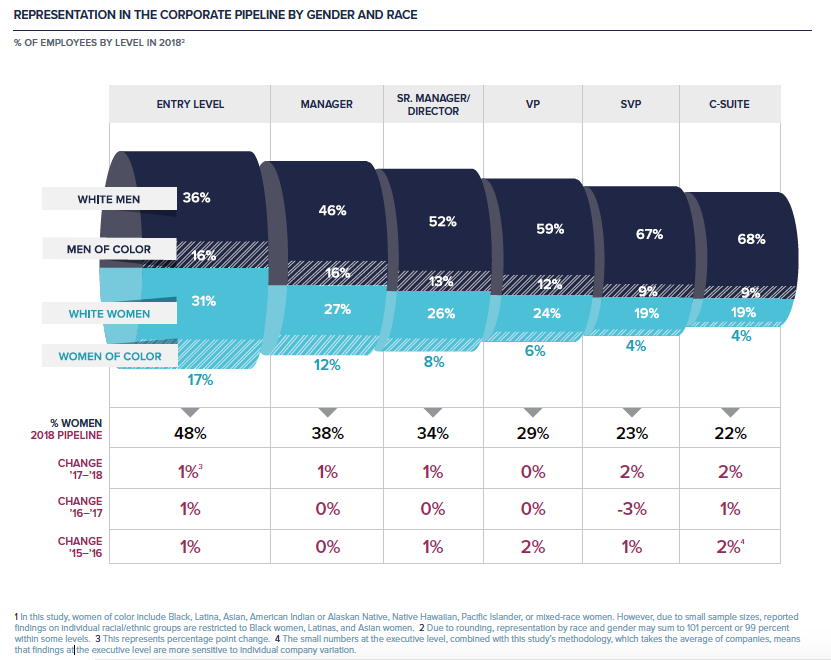For the last four years, McKinsey and Lean In have published in-depth reports on the state of women in the workplace. Their 2018 report, released this October, was clear – the needle has barely moved since they started conducting surveys with thousands of employees at hundreds of companies, despite significantly more attention being placed on issues of gender in the workplace. The report concludes by indicating that companies say they want to make change, but aren’t actually doing the work to make it happen. The authors outline several steps to make change happen. We’re including some highlights from the report as well as recommended actions to take in order to start making real change at work.
Representation in the corporate pipeline
Women have made very little progress in terms of representation throughout every stage of the career pipeline, and women of color have fared even worse. As the below graph shows, women, and particularly women of color, are less represented the higher up the corporate ladder you look. Representation at the highest levels indicates that white men are overrepresented–this trend takes effect as early on in the pipeline as the management stage.
Key drivers for lack of change
There are several suggested reasons for this lack of change. Microaggressions, less managerial support, unfair performance reviews, less access to senior leaders, are all more likely to be experienced by women. Additionally, 20% of women are “Onlys” – in other words, the only X in a team or at a certain level within the company. Onlys struggle to stay at their company for a variety of reasons, despite having greater ambitions to be promoted and to become a top executive. Over 80% are on the receiving end of microaggressions, compared to 64% of women as a whole, and experience feelings of isolation and a greater pressure to perform.
Perception vs reality
Despite the above, men think leaders are doing a better job promoting gender diversity than women do. Men are almost twice as likely as women to think managers challenge gender-biased language and behavior, and almost 1.5 times more likely to say that senior leaders offer guidance on how to advance women and improve gender diversity. On top of this, 15% of men think their gender will make it harder for them to advance, despite their overwhelming representation in the workplace.
Corporate commitment to gender diversity
In 2017, 90% of companies said they prioritized gender diversity, while only 84% say they’re prioritizing it this year. Employees also recognize the difference and downwards trend. Last year, 56% said their organization was committed to gender diversity, while this year 45% believe it’s the case. On top of this, while 76% of companies say they’ve made the business case for gender diversity, only 13% have actually worked to calculate the positive impact on the business. This trickles down to how employees feel their manager is committed to diversity. Only 39% of women and 47% of men think it’s a high priority for their manager. We believe this may correlate to recent findings that there is a sense of ‘diversity fatigue’ for many at work.
Concrete ways to make change
The report does an excellent job of including concrete ways that companies can do better in taking action to address fair gender representation, and includes examples from other successful companies who have done the work and have seen change for the better. These action items include the following:
- Get the basics right – targets, reporting, accountability
- Ensure that hiring and promotions are fair
- Make senior leaders and managers champions of diversity
- Foster an inclusive and respectful culture
- Make the “Only” experience rare
- Offer employees the flexibility to fit work into their lives
We hope you get a chance to read the full report for more details and ways to take concrete steps toward more gender equity in the workplace.

